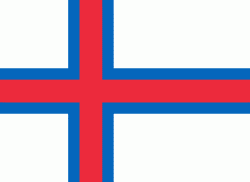Eysturoy (Eysturoyar sýsla)
Eysturoy is separated by a narrow sound from the main island of Streymoy. Eysturoy is extremely rugged, with some 66 separate mountain peaks, including Slættaratindur, the highest peak in the archipelago at 880 m. The country's two longest fjords, Skálafjørður in the south and Funningsfjørður in the north, almost split the island in two halves. The isthmus in between, Millum Fjarða, is one of the flattest areas in the country. Important settlements on Eysturoy are Fuglafjørður in the north and the densely populated area of the municipalities of Runavík and Nes in the south.
Eysturoy is connected with Streymoy by the Streymin Bridge over the Sundini. Leirvík on the east coast of the island is the gateway for transport connections to the north-eastern islands, particularly Klaksvík on the island of Borðoy, which is the Faroes' second-largest town. In December 2020, the sub-sea Eysturoyartunnilin (the Eysturoy Tunnel) was opened, creating a direct link between Runavík, Strendur and Tórshavn.
Sites of interest on Eysturoy include the villages of Eiði and Gjógv, the latter having a small natural port in a rock column; the Blásastova historical museum in the village of Gøta; and the 18 C varmakelda (thermal springs) of Fuglafjørður. Off the northern tip of the island are the basalt sea stacks Risin og Kellingin.
The town of Glyvrar on the eastern coast of Eysturoy is the home-base for Bakkafrost, the largest company in the Faroe Islands. Bakkafrost is the eighth-largest fishing company worldwide. Four out of ten Premier league football clubs are in Eysturoy: IF (Fuglafjørður), NSÍ (Runavík), Skála ÍF and Víkingur (Leirvík). There are regional rowing festivals in Fuglafjørður (Varmakelda), Runavík (Eystanstevna), and one alternating between Skáli, Strendur and Vestmanna (Fjarðastevna). Accepted grind beaches are in Fuglafjørður, Funningsfjørður, Norðra- and Syðragøta, Norðskáli and Skálafjørður.
Map - Eysturoy (Eysturoyar sýsla)
Map
Country - Faroe_Island
 |
 |
They are located 200 mi north-northwest of the United Kingdom, and about halfway between Norway (360 mi away) and Iceland (270 mi away). The islands form part of the Kingdom of Denmark, along with mainland Denmark and Greenland. The islands have a total area of about 540 sqmi with a population of 54,000 as of June 2022.
Currency / Language
| ISO | Currency | Symbol | Significant figures |
|---|---|---|---|
| DKK | Danish krone | kr | 2 |
| ISO | Language |
|---|---|
| DA | Danish language |
| FO | Faroese language |















